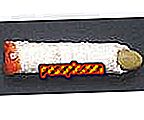How to survive in the Sahara desert

The Sahara desert is a challenge, surely one of the hottest and deadliest places on the planet where year after year hundreds of dehydrated people die trying to cross it. It is located in North Africa and is so large in size that it occupies a quarter of the African continent, covers no less than 11 countries.
Characteristics of the Sahara desert
The Sahara or Sahara desert "the Great Desert" is the largest warm desert in the world and the third largest after the Antarctic and the Arctic. With an area of more than 9, 065, 000 km2, it covers most of North Africa, occupying an area almost as large as that of China or the United States. The Sahara extends from the Red Sea, including parts of the coast of the Mediterranean Sea, to the Atlantic Ocean. To the south, it is bounded by the Sahel, a belt of semi-arid tropical savannah that forms the regions that cover the north of sub-Saharan Africa. Some of the sand dunes of the Sahara can reach 193 m in height.

How to survive
If you get lost in a desert, the chances of surviving are one in a million, you will die dehydrated or by sunstroke. No person could resist it, a certain death in a matter of hours.
If you want to fight for your life and not give up, the first thing you have to do is cover your head to avoid sunstroke. That is the first step to survival. Remember that this is the hottest desert in the world and in summer the 58 degrees are reached with great ease.
Food is also important, you should do it often and in small quantities, if you eat too much digestion absorbs all the water in your body, you will dizzy and you can not avoid a dehydration that will dry.
If it is your lucky day and you cross with a palm tree, take the opportunity to eat some date and then protect yourself from the sun in the shade by digging a bit in the sand. Rest there until the sun begins to set. Take a breath, recover your strength and never decay. The power is in your mind, not in the body. Do not get carried away by the situation. We know, you're on the edge.
High temperatures often cause headaches, if you stop sweating and tides you are probably suffering the consequences of heat stroke. Calculate that in the desert you can lose up to a liter of water per hour. Recover liquids as soon as possible.
If you think that without clothes you will spend less heat, do not be so sure. Clothing is a protective filter for the effects of heat and wind that can dry your skin. Do not take it off, it will protect you. Here we explain how to dress in Morocco.
Orient yourself in the Sahara
The orientation in a desert like the Sahara is not easy, the only guide is the sun, always go in the same direction taking as reference the sun.
If you find a bird over your head, follow it . The birds are always near where there is water, maybe an oasis. So, look for sure that there is a source nearby where you can hydrate to continue.
Finally, as long as you have good orientation, advance at night, you will avoid the effects of devastating heat, but be careful, there may be poisonous snakes lurking. They also like to go out at this time to take a walk. The key to avoid them is to stomp on the ground to cause vibrations and drive them away.
Now you are ready for the adventure. Good luck!

